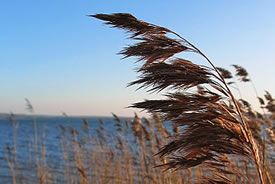
Phragmites (Photo by Wikimedia Commons)
Phragmites
Phragmites (also known as common reed) is a perennial grass that grows up to five metres tall. It grows in wet and damp habitats, and is often found growing in roadside ditches.
Native to Europe and Asia, this species has invaded many wetlands in eastern North America. This invasive species outcompetes native wetland plants, and is a serious threat to biodiversity.
Once introduced into an area, the plant's roots spread far and wide below wetlands in a vast network of rhizomes.
How is it identified?
Phragmites is identified by its leaves, which are blue-green, wider than one centimetre and grow in sheaths attached to the stem. The flowers, which appear in late summer, grow in a dense cluster.
How does it grow?
Its seeds are easily wind-dispersed, allowing it to further invade other habitats.
Where does it grow?
Phragmites grows in wetlands in temperate and tropical regions. Although it prefers wet areas, it can spread away from water into adjacent drier habitats, including sandy beaches and dunes.
What does it threaten?
Thick stands choke out native plants' growth, provide poor wildlife habitat and disrupt natural wetland functions. Dead stalks from previous years’ growth can increase fire risk. Phragmites grows so tightly that animals, including turtles, can't use the wetland anymore. Although some birds may nest in its thickets, the plant does not provide ideal habitat since phragmites doesn't support enough insects for them to feed their young.
What is NCC doing to control this invasive species?
In southwestern Ontario, the Nature Conservancy of Canada (NCC) is actively removing this species on a number of properties. Because the roots of this plant grow so deep, it is difficult to remove, and involves a few steps:
- In some situations, the dead plant material is burned during the winter or very early spring. This removes the material, and kills some of the seeds.
- The plant is then allowed to grow up from the large root system all summer, and is sprayed with herbicide in the early fall. This kills the roots, so the plant does not regrow during the following year.
Burning itself does not really harm the plant, but it makes it much easier to work with and reduces the volume of herbicide required.
In Middle Point woods on Pelee Island, NCC staff have eradicated an 800-metre-long population of the plant. The cleared area now supports at least 20 native plants, and staff have seen snapping turtles, and Lake Erie watersnakes and eastern foxsnakes (all species at risk) using the area. Further evidence of their success has been the natural establishment of a swamp rosemallow plant — or native hibiscus — a species at risk with beautiful, large pink flowers.
In Quebec, NCC has undertaken a colossal task at tackling phragmites at the upper marshes on Île aux Grues in the St. Lawrence River, 80 kilometres east of Quebec City. Given the fragile nature of the area, NCC had to be inventive in invasive species control and eradication methods where chemical controls are prohibited. A wide-scale project was launched in 2019 using a combination of mowing and tarping, totalling four hectares of this ecosystem. Over the next few years, there’ll be monitoring and regular maintenance on the colonies and tarps will be removed in 2025, followed by revegetation of the area with native species to restore the upper marshes’ rich biodiversity.
How can you help?
Read the Best Management Practices here
Everyone can help to win the battle against alien invasive species. Here are some ways you can help:
- Professional help is recommended. The most effective method is a three-step combination of spraying with herbicide, mowing and controlled burning repeated over three years or until the patch is eradicated.
- Dispose of yard waste properly. Dumping yard waste in natural areas can introduce alien invasive species that will thrive and spread. Even leaf piles can be problematic, as dumped piles can smother native vegetation. Contact your municipality to find out how to dispose of yard waste properly.
- Plant native species in your garden! There are lots of beautiful native species that attract native butterflies and birds, making your garden twice as beautiful. Native species are also adapted to our climate and often require less rigorous care than exotic species.
- Report sightings of invasive plants to your local stewardship council. Finding these invasions early is a key to eradicating them.
- Clean your shoes or bicycle tires when moving between designated trails in different areas. Invasive plants are often spread accidentally from seeds stuck in treads.




